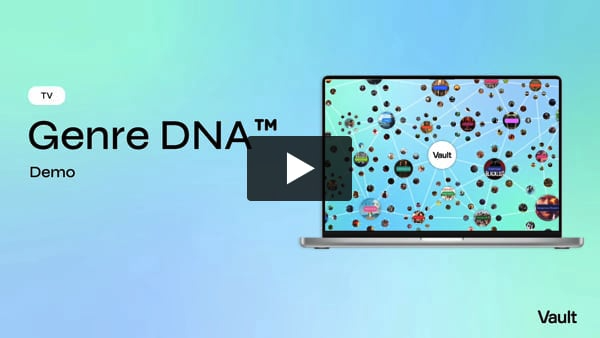Rapid Insights: Family Narratives and Other Key Drivers Behind Successful Historical Sagas

This week, we wanted to celebrate the introduction of Vault’s new Genre DNA™capabilities by diving into the landscape of a popular scripted subgenre that encompasses a wide variety of series: Historical Sagas. We took a closer look at the data to see what separates the truly stand-out successes–those that hit the zeitgeist, achieve popular acclaim, and, ideally, run for many seasons–from the rest of the pack.
Here’s what you need to know about the Historical Saga subgenre:
Vault uses index scores to describe the impact a given story/theme/element will have on specific KPIs:
≤79 Disappointing 80-89 Challenging 90-109 Average 110-119 Promising 120+ Outstanding
Who’s the core audience for a successful historical saga?
Older viewers. While a standout period drama can effectively appeal to either gender–and there are numerous examples in both camps, from the male-skewing Shōgun (62%), Peaky Blinders (65%) and Deadwood (60%) to the female-heavy Bridgerton (83%), The Marvelous Mrs. Maisel (68%), and The Crown (72%)–the core demo they all have in common is a viewership that’s primarily aged 30+ (63-96%). The most popular shows seem comfortable leaning heavily into this built-in older audience, whereas less successful entrants in the subgenre, in contrast, tend to aim just a little bit younger.
What’s one of the key draws of the subgenre?
A subculture deep-dive. The most compelling historical sagas on TV share a common thread: they all excel at bringing a specific time period to life, creating vivid, fully-realized worlds that viewers can’t resist exploring. Outlander, for example, time-travels between different periods in English and Scottish history (British Culture, 121); Peaky Blinders showcases a seedy Criminal Organization (129) in 1919; Downton Abbey looks at the upstairs-downstairs divide of English High Society (160), The Crown at modern English Royalty (160), Vikings at early Norse explorers (A Subculture Up Close, 119), Mad Men at 1960s Madison Avenue (A Subculture Up Close, 123), and 1923 at early twentieth-century American History (139). For these and other hit series, viewers tune in–and keep watching–to spend time in a rich, compelling, fully-fleshed out world that they haven’t seen before, and this aspect is an important driver across all four of our key categories (ratings, bingeability, social buzz, and longevity).
What’s the main storytelling approach among the most popular shows?
A focus on family. Across the most popular historical sagas on television, one storytelling approach consistently emerges as a key to success: anchoring the narrative in the dynamics of family relationships. From a family-run crime gang (Peaky Blinders, Family Relationships, 137) to a pair of married Russian spies (The Americans, Working with Family, 159), a tight-knit Scottish clan (Outlander, Extended Family, 126) to royalty confronting succession (The Crown, Family Legacy, 152), and a chaotic New York Jewish household (The Marvelous Mrs. Maisel, Family Disagreements, 160) to a kinship of Viking raiders (Vikings, Family Relationships, 160), the best series lean on the universality of family to keep their otherwise alien stories feeling grounded and relatable. In contrast, less successful historical sagas are more likely to feature other types of relationships (co-workers, teams, friends, wider communities) that, from the audience’s perspective, may not provide as rich a milieu to explore the norms of different eras.
Is there one specific tone that determines success?
Not at all. The top period dramas depend on a wide range of emotional experiences to pull in viewers. Some tend toward the upbeat and positive, calling up emotions like Amazement, Joy, Optimism, Love, and Awe (e.g., Bridgerton, Call the Midwife, The Chosen); others swing negative, drawing on darker feelings like Anger, Sadness, Contempt, Loathing, and Fear (e.g., 1923, Deadwood, Peaky Blinders, Boardwalk Empire); and still others revel in covering both the highs and lows of the human experience in equal measure (e.g., Shōgun, The Crown, Downton Abbey, Hell on Wheels, Reign).
Redefine your understanding of scripted TV subgenres
Introducing Genre DNA™ – 26 scripted TV subgenres redefined by groundbreaking AI analysis to reveal the true drivers of viewership.
See the insights that others can’t
Genre DNA™ goes beyond traditional TV genre classifications by analyzing over 1,000 scripted series on both linear and SVOD platforms from the last 5 years.
Each Vault Genre DNA™ report offers a precise analysis of your chosen scripted TV subgenre, uncovering its unique drivers of viewership.
*Publicly released trailers for series are evaluated using Vault’s algorithms – utilizing our proprietary 120K+ story element database alongside viewership performance and other datasets – to identify unique combinations of stories, themes, characters, and genre elements that will drive success.
